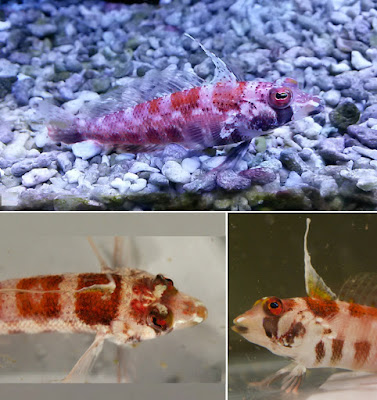 |
| Parapercis altipinnis
Ho & Heden, 2017
|
Abstract
A new species sandperch, Parapercis altipinnis, is described based on the holotype collected from Cebu, the Philippines at 55–65 m by SCUBA. The new species belongs to the P. cylindrica complex and can be distinguished by an extremely high first dorsal fin, the first spine slightly longer than the head; 3 predorsal scales; 42 or 43 lateral-line scales; teeth present on vomer and palatines. The body is reddish dorsally and blackish ventrally, with 5 large brownish saddles alternating with white bands on dorsal surface; scattered dots on top of head, first dorsal fin and dorsal surface; first dorsal fin milky white with 5 black marks on anterior margin; a black broad band below eye; cheek and throat blackish red surrounding by white color; row of 10 short white bars along the lateral side of body axis; row of 9 deep red to blackish bars on lower half of lateral side of body; base of pelvic fin and lower margin of caudal fin blackish; rows of black spots on soft dorsal fin. A key to the species of the complex is provided.
Keywords: Pisces, Teleostei; taxonomy, Parapercis altipinnis, new species
Parapercis altipinnis sp. nov.
English name: Karen's sandperch
Parapercis sp. 5: Kuiter & Tonozuka, 2001:569,
fig. A–B (Bali, Indonesia, underwater photograph only).
fig. A–B (Bali, Indonesia, underwater photograph only).
Holotype. NMMB-P26107, 50.3 mm SL, Cebu, the Philippines, ca. 55–65 m, hand net, SCUBA diving, and purchased from an aquarium in Belgium in December, 2016.
Diagnosis. Dorsal-fin rays V, 21; anal-fin rays I, 17; pectoral-fin rays 14 or 15; lateral-line scales 42 or 43; gill rakers on first gill arch 3 + 7; predorsal scales 3; small, partly embedded, cycloid scales on anterior portion and large ctenoid scales in about 4 rows on posterior portion of cheek; single row of vomerine teeth in curved band; palatine teeth present; prominent sharp spine at upper edge of subopercle present; body depth 4.1 in SL (24.3% SL); first two dorsal-fin spines elongate, first slightly longer than head length, second about half length of first; membrane from last dorsal-fin spine joined to base of first soft ray; caudal fin slightly rounded. When alive, body reddish dorsally and blackish ventrally; 5 large brown saddles on dorsal surface; scattered dots on top of head, first dorsal fin and dorsal surface of back; first dorsal fin whitish with 5 black mark on anterior margin of first spine; a black band below eye; cheek and throat blackish; row of 10 white short bars along lateral side of body axis; row of 9 blackish red bars on lower half of lateral body; base of pelvic fin and lower half of caudal fin blackish; row of black spots on base of soft dorsal fin.
Etymology. The specific name is derived from the Latin alti (long) and pinnis (fin) in referring to the extremely high first dorsal fin.
Distribution. Known only from the holotype collected from Cebu, the Philippines, at around 55–65 m depth.
Ecological note. That Parapercis is generally believed to be protogynous and that the change from female to male is often accompanied by color changes, but not elongation of certain fin rays (Ho, pers. obse.). The holotype has a pairs of saccus connecting to the cloaca, which are most likely ovaries but without eggs. The specimen might be a juvenile or a mature female just after spawning. Underwater photographs of a male individual are provided in Kuiter & Tonozuka (2001; as Parapercis sp. 5). It shows sexual dimorphism in the coloration, but not the high dorsal fin, in present species.
Hsuan-Ching Ho and Miranda V. Heden. 2017. A New Species of the Sandperch Genus Parapercis from the Philippines (Perciformes: Pinguipedidae). Zootaxa. 4341(4); 563–569. DOI: 10.11646/zootaxa.4341.4.8


